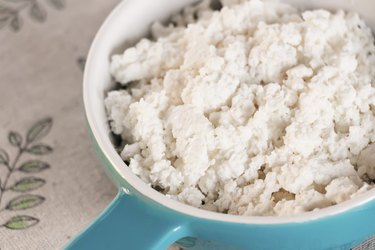
Commercial cottage-cheese production differs from home production in scale, not method, and it's the easiest facet of cheese-making for a home cook to learn. You likely have all the necessary ingredients at home already -- milk and lemon juice or vinegar -- so you can apply professional techniques to produce a creamy cottage cheese with little investment in about 30 minutes.
Production Methods and Starters
Video of the Day
The short-set method, which takes about 5 hours, uses buttermilk and rennet for coagulation and produces large curds. For the long-set method, which takes about 15 hours, you use only buttermilk and it creates small curds. Quick cottage cheese, or farmer's cheese, uses a food acid, such as vinegar or lemon, for coagulation and takes about 30 minutes to make. The quick version is the easiest type to make at home and a good introduction to cheese-making.
Video of the Day
Types of Milk
Fresh, non-homogenized cow's milk makes the best cottage cheese. Homogenization breaks up the butterfat into droplets and disperses them through the liquid, creating the uniformly white milk you see on supermarket shelves -- good for drinking, not for cheese-making. Quality cottage cheese has little free cream; most of it encapsulates and comprises the curds. The fat in homogenized milk stays suspended in the liquid -- when it's used in cottage-cheese making there's too much free cream, resulting in too dry a curd for U.S. Department of Agriculture standards. But if you're making quick cottage cheese at home, USDA standards don't apply, and you can remedy the dryness with heavy cream. If you can't get unpasteurized fresh milk, use skim milk.
Sanitary Practices
Few procedures in food production require as fastidious an approach to cleanliness as cheese-making. Live cultures and bacteria make fresh cheese highly perishable, and you must follow every step for food safety. The USDA requires commercial cheese-makers to follow the strictest hygienic standards possible throughout every step of cottage-cheese production; not a speck of dust or debris makes it into the technological rooms of a cheese-production facility.
Home Sterilization
You don't have to put stringent commercial controls in place when you make cottage cheese at home, but you have to use sterile equipment. To sterilize the equipment you need to make cottage cheese at home, fill a large pot with water and drop a teaspoon, a 1-cup measuring cup and tongs into it. Boil the water for 5 minutes; drain and retrieve the spoon and cup using tongs after they cool.
Creaming for Smoothness
The USDA requires commercially produced cottage cheese to have an even layer of heavy cream encapsulating each curd particle, and the free cream and water they're dispersed must have a thick consistency. Commercial producers use a creaming process toward the end of production to meet quality standards. You can replicate the creaming process at home by mixing about 1/2 cup of heavy cream into every 1-gallon batch of cottage cheese.
Homemade Cottage Cheese
Heat skim milk on the stove over medium-low heat until it barely starts simmering, and take it off the burner. Stir in 1/2 cup of vinegar or lemon juice for every gallon of milk; let the cheese sit for 30 minutes then strain it though a cheesecloth-lined strainer. Bundle the curds in the cheesecloth and rinse them under cool water for 5 minutes. Season to taste with salt and add heavy cream.